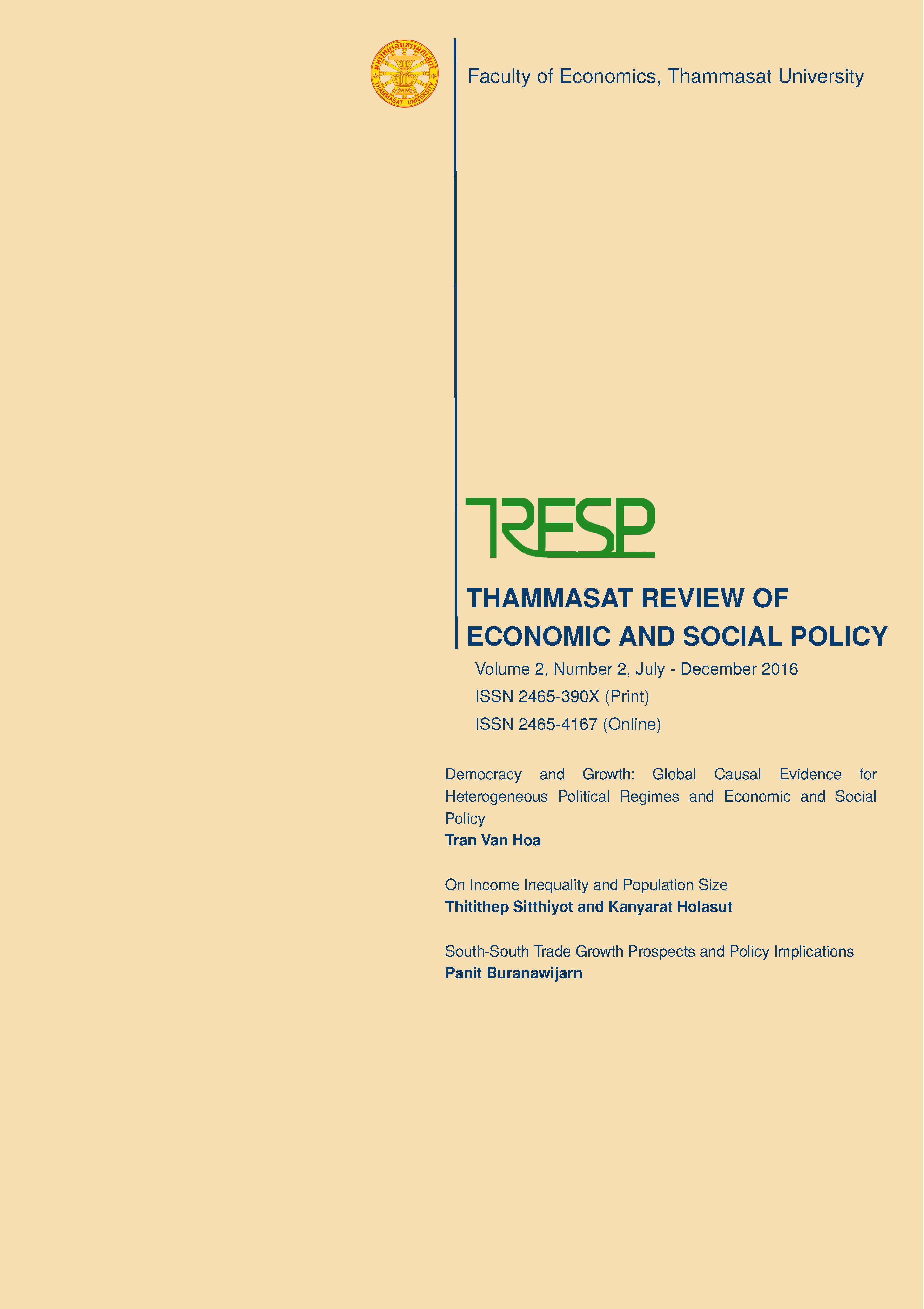South-South Trade Growth Prospects and Policy Implications
DOI:
https://doi.org/10.14456/tresp.2016.9Keywords:
South-South Trade, China, India, economic developmentAbstract
South-South Trade, or more broadly South-South Cooperation, is the collaboration between developing countries of the Global South across various dimensions such as political, economic, and social issues. This paper analyses trends and developments in the trade between developing countries in contrast to other orientations of trade, focusing particularly on China and India. The paper looks at their trade flows, as well as their other activities which fall under the aegis of South-South Cooperation. Lastly, the literature on South-South Trade is reviewed to study the motivation for engaging and encouraging South-South Trade, as well as its overall effectiveness. Policy recommendations for the development of South-South Trade are made based on evidence from the study.
References
Aksoy, A. & Ng, F. (2014). Increased export performance and competitiveness of developing countries is mainly a China story. Retrieved from http://www.voxeu.org/article/south-south-trade-it-smostly-china
Arvis, J-F., Duval, Y., Shepherd, B. & Utoktham, C. (2013). Trade Costs in the Developing World. Poverty Reduction and Economic Management Network Policy Research Working Paper Series, No. 6309. Washington D.C.: The World Bank.
Asian Development Bank-Asian Development Bank Institute (2014). ASEAN, PRC, and India: The Great Transformation. Tokyo: Asian Development Bank Institute.
Baldwin, R. (2014). Trade and Industrialization after Globalization's Second Unbundling: How Building and Joining a Supply Chain Are Different and Why it Matters, in Feenstra, R., and A. Taylor (eds) Globalization in an Age of Crisis: Multilateral Economic Cooperation in the Twenty-First Century. Chicago: University of Chicago Press.
Behar, A. & Cirera, L. (2010). The impact of North-South and South-South trade agreements on bilateral trade. CSAE Working Paper Series, No. 2010-30. Oxford: Centre for the Study of African Economies.
Paton, J. & Guo, A. (2014, November 10). Russia, China add to $400 billion gas deal with accord. Bloomberg. Retrieved from http://www.bloomberg.com/news/2014-11-10/russia-china-add-to-400-billion-gas-dealwithaccord.html
Cadot, O. & de Melo, J. (2014). Aid for Trade: What have we learnt? Which way ahead? Washington D.C.: Center for Economic and Policy Research.
De, P. (2006). Why Trade Costs Matter? Asia-Pacific Research and Training Network on Trade Working Paper Series, No. 7. Bangkok: United Nations Economic and Social Commission for Asia and the Pacific.
Einhorn, B. (2016, October 20). China’s housing bubble wobble. Bloomberg. Retrieved from http://www.bloomberg.com/news/articles/2016-10-20/china-s-housing-bubble-wobble
Evenett, S. & Fritz, J. (2016). Global trade plateaus. Retrieved from http://www.voxeu.org/article/globaltrade-plateaus
Frankel, J. (1997). Regional Trading Blocs in the World Economic System. Washington D.C.: Peterson Institute for International Economics.
Hanauer, L. & Morris, L. (2014). Chinese Engagement in Africa. Nation Security Research Division, RAND Corporation. Washington D.C.: RAND Corporation.
Hühne, P., Meyer, B. & Nunnenkamp, P. (2014). Does Aidfor-Trade from the North promote South-South Trade? Kiel Working Paper Series, No. 1918. Kiel: Kiel Institute for the World Economy.
Kastrenakes, J. (2016, April 27). Lenovo and Xiaomi no longer among top 5 smartphone makers. The Verge. Retrieved from http://www.theverge.com/2016/4/27/11521178/lenovoxiaomi-overtaken-in-smartphone-shipments
Kurokawa, K., Tembo, F. & te Velde, D. (2010). Challenge for the OVOP Movement in Sub-Saharan Africa. JICA Research Institute Working Paper Series, No. 18. Tokyo: Japan International Cooperation Agency Research Institute.
Newfarmer, R. (2006). Regional Trade Agreements: Designs for Development in Newfarmer, R. (eds) Trade, Doha, and Development: Window in the Issues. Washington D.C.: The World Bank.
Organisation for Economic Co-operation and Development (2012a). Trade-related South-South Co-operation: China. Policy Dialogue on Aid for Trade. Paris: Organisation for Economic Co-operation and Development.
Organisation for Economic Co-operation and Development (2012b). Trade-related South-South Co-operation: India. Policy Dialogue on Aid for Trade. Paris: Organisation for Economic Co-operation and Development.
Page, S. (2004). South-South Trade in The Doha Development Agenda Impacts on Trade and Poverty. London: Overseas Development Institute.
Ratna, R. (2009). Promoting South-South Trade: Recent Developments and Options. ARNeT Policy Brief Series, No. 17. Bangkok: United Nations Economic and Social Commission for Asia and the Pacific.
Songwanich, S. (2016, April 25). China’s new gold fix. The Nation. Retrieved from http://www.nationmultimedia.com/opinion/Chinasnew-gold-fix-30284591.html
Sun, Y. (2014). Africa in China’s Foreign Policy. Washington D.C.: Brookings Institute.
Trefler, D. (1993). International Factor Price Differences. Journal of Political Economy, 101(6), 961-987.
Udeala, S. (2010). Nigeria-China economic relations under the South-South Cooperation. African Journal of International Affairs, 13(1), 61-88.
United Nations Conference on Trade and Development (2016). Data retrieved October 10, 2016 from http://unctadstat.unctad.org/wds/ReportFolders/reportFolders.aspx
United Nations Statistics Division (2016). Data retrieved July 7, 2016, from http://comtrade.un.org/.
World Bank (2014). Logistics Performance Index: Connecting to Compete 2014: Trade Logistics in the Global Economy. Washington D.C.: The World Bank.
World Trade Organisation (2015). International Trade Statistics 2015. Retrieved from https://www.wto.org/english/res_e/statis_e/its2015_e/its2015_e.pdf
Xing, Y. (2014). Measuring Value Added in the People’s Republic of China’s Exports: A Direct Approach. ADBI Working Paper Series No. 493. Tokyo: Asian Development Bank Institute.



